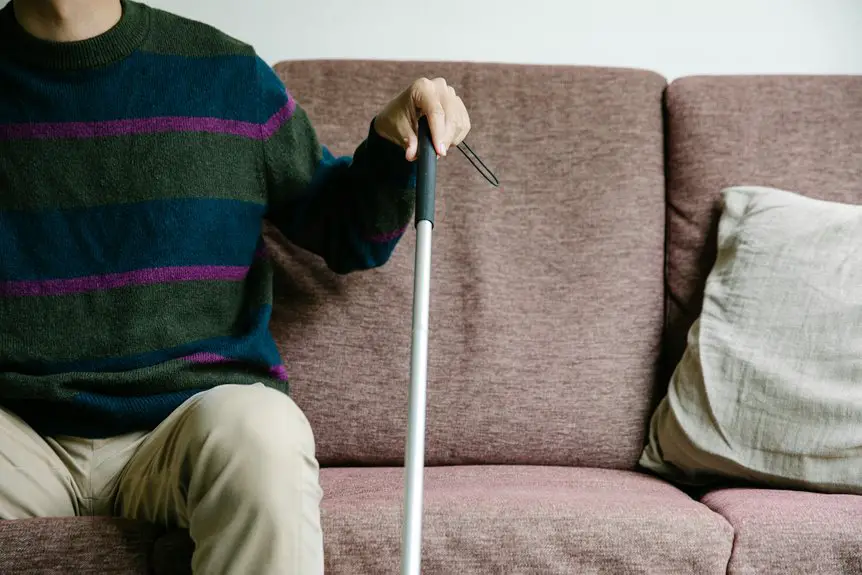Chinos are typically made from cotton twill fabric, which combines durability, breathability, and a smooth texture for a polished look. You’ll find different cotton variants used—from soft combed cotton to eco-friendly organic cotton—with occasional synthetic blends that add stretch and wrinkle resistance. The medium-weight twill guarantees comfort across seasons and stands apart from heavier, rougher denim. If you want to understand what makes quality chinos last and how fabric choice affects style and care, you’re in the right place.
Table of Contents
Key Takeaways
- Chinos are primarily made from cotton or cotton blends, offering softness, durability, and breathability.
- Combed cotton and organic cotton variants enhance smoothness, strength, and eco-friendliness.
- Synthetic fibers may be blended with cotton to improve stretch, wrinkle resistance, and fabric longevity.
- Medium to heavy cotton twill with a tight weave ensures durability and a smooth texture in chinos.
- Chino fabric is lighter and smoother than denim, designed for dressier casual wear with a fine twill weave.
The History of Chino Fabric
Although you mightn’t realize it, chino fabric has a rich history dating back to the 19th century when it was first used to make military uniforms. You’ll find that its durability and comfort made it ideal for soldiers, especially during the Spanish-American War.
The fabric’s practical qualities quickly caught on beyond the military, becoming popular for everyday wear. When you wear chinos today, you’re embracing a piece of that legacy—combining function with style.
Over time, chino fabric shifted from purely utilitarian use to a fashion staple, prized for its clean look and versatility. By understanding this background, you can appreciate why chinos remain a timeless choice, seamlessly blending history with modern comfort and practicality.
Understanding Cotton Twill Weave
You’ll find that cotton fibers create a soft yet strong base for chinos.
The twill weave gives the fabric its distinctive diagonal pattern, boosting both texture and durability.
Understanding these elements helps you appreciate why chinos feel comfortable and last long.
Cotton Fibers Explained
Cotton fibers form the foundation of most chinos, giving them their softness and durability. When you choose chinos, you’re picking a fabric made from natural plant fibers harvested from cotton bolls.
These fibers are strong yet flexible, which lets chinos feel comfortable while standing up to everyday wear. Cotton’s breathability helps keep you cool, making chinos ideal for warmer weather.
You’ll also notice that cotton fibers absorb dyes well, so chinos often come in vibrant, lasting colors. Because cotton is natural, it’s hypoallergenic and gentle on your skin.
When you care for your chinos properly—washing them in cool water and avoiding harsh detergents—you preserve the integrity of these fibers, ensuring your chinos stay soft and durable over time.
Twill Weave Characteristics
When you look closely at chinos, you’ll notice their distinctive diagonal pattern—that’s the hallmark of the twill weave. This weave creates a series of fine, parallel ribs, formed by the weft thread passing over one or more warp threads before going under two or more.
You’ll find that this structure gives the fabric a unique texture and a subtle sheen. The diagonal lines you see aren’t just for looks—they help the fabric drape nicely and resist wrinkles better than plain weaves.
Because the twill weave interlaces threads in a pattern, it also allows for more flexibility and stretch, making chinos comfortable to wear. Understanding this pattern helps you appreciate why chinos feel different from other cotton garments.
Durability and Texture
Although twill weave contributes to chinos’ distinct look, it also plays an essential role in their durability and texture. When you wear chinos, you’re benefiting from the strong diagonal pattern of cotton twill, which resists wear and tear better than plain weaves. This means your chinos can handle daily use without easily showing signs of damage.
The texture feels smooth yet substantial, giving you comfort without sacrificing toughness. You’ll notice a slight ribbed surface, which adds character and helps hide minor stains or wrinkles.
Because twill weave is dense but flexible, chinos maintain their shape while allowing movement. So, when you choose chinos, you’re opting for fabric that’s both sturdy and stylish, ready to stand up to your active lifestyle.
Common Fibers Used in Chinos
You’ll often find chinos made from different cotton variants, each offering unique softness and durability.
Some blends mix cotton with synthetic fibers to boost stretch and wrinkle resistance.
Understanding these common fibers helps you pick chinos that fit your lifestyle and comfort needs.
Cotton Variants
Because cotton is the foundation of most chinos, understanding its variants helps you choose the right pair for your needs.
You’ll find that most chinos use either combed cotton, which is smoother and stronger due to the removal of shorter fibers, or organic cotton, prized for its eco-friendly cultivation without harmful chemicals.
Egyptian cotton offers extra softness and durability, making chinos feel luxurious and last longer.
Pima cotton, similar to Egyptian, boasts long fibers that create a silky texture and resist pilling.
Each variant affects breathability, comfort, and wear over time.
When selecting chinos, consider which cotton variant aligns with your preferences for softness, durability, and sustainability to guarantee you pick a pair that suits your lifestyle perfectly.
Synthetic Blends
Many chinos incorporate synthetic fibers to enhance durability, stretch, and wrinkle resistance.
When you choose chinos with synthetic blends, you get the best of both worlds: the natural comfort of cotton and the performance benefits of synthetics. These blends help your chinos hold their shape and stay looking sharp throughout the day.
Common synthetic fibers used in chinos include:
- Polyester: Adds strength and reduces shrinkage.
- Elastane (Spandex): Provides stretch for better mobility.
- Nylon: Increases abrasion resistance and durability.
- Rayon: Enhances softness and drape.
Differences Between Chino and Denim Fabric
Although both chino and denim fabrics are popular choices for casual wear, they differ markedly in texture, weight, and construction. Chino fabric feels smoother and lighter, woven with a twill weave that gives it a fine diagonal pattern. Denim, on the other hand, is heavier and coarser, crafted with a sturdy twill weave that creates a rugged texture. These differences affect comfort, durability, and style. Here’s a quick comparison:
| Feature | Chino Fabric | Denim Fabric |
|---|---|---|
| Texture | Smooth, fine twill | Coarse, rugged twill |
| Weight | Lightweight | Heavyweight |
| Typical Use | Dressier casual wear | Casual, workwear |
Knowing these distinctions helps you pick the right fabric for your needs.
The Role of Cotton in Chinos
Cotton forms the foundation of most chino fabrics, giving them their signature softness and breathability. When you choose cotton chinos, you’re opting for comfort that lasts throughout the day.
Cotton fibers allow air to circulate, keeping you cool in warm weather, and they absorb moisture, which helps prevent discomfort. Plus, cotton’s natural durability means your chinos will hold up well to regular wear.
Here’s why cotton is essential in chinos:
- Provides softness against your skin
- Enhances breathability for all-day comfort
- Absorbs sweat, reducing stickiness
- Offers strength for long-lasting wear
Blended Fabrics in Chino Manufacturing
While cotton forms the heart of traditional chinos, fabric blends have gained popularity for adding extra benefits.
You’ll often find chinos made from cotton combined with synthetic fibers like polyester or elastane. This blend enhances durability, making the pants more resistant to wear and tear.
Plus, it improves stretch and flexibility, so you can move comfortably throughout your day. Blended fabrics also tend to wrinkle less, helping your chinos maintain a crisp look without constant ironing.
Some blends improve moisture-wicking, keeping you cool and dry. When you pick chinos with blended fabrics, you get the natural breathability of cotton alongside the performance perks of synthetics.
This combination makes chinos more versatile for both casual outings and active wear.
How Fabric Weight Impacts Chino Comfort
You’ll notice that lightweight chinos keep you cool and comfortable in warmer weather, while heavyweight fabrics provide extra warmth when it’s chilly.
Choosing the right fabric weight can make a big difference in how your chinos feel throughout the seasons.
Let’s explore how to pick the best weight for your comfort and style.
Lightweight Fabrics Benefits
Because fabric weight directly affects breathability and ease of movement, choosing lightweight chinos can transform your comfort throughout the day.
When you opt for lighter fabrics, you experience less heat buildup and more flexibility, perfect for warmer climates or active days. Lightweight chinos also dry faster, reducing discomfort from sweat.
Plus, they tend to feel softer against your skin, enhancing your overall wear experience.
Here’s what you gain with lightweight chino fabrics:
- Improved ventilation keeps you cool.
- Greater freedom of movement.
- Quick moisture evaporation.
- Softer, more comfortable texture.
Heavyweight Fabrics Warmth
Though heavier fabrics may feel bulkier, they provide essential warmth that lightweight chinos can’t match, making them ideal for cooler weather. When you choose heavyweight chinos, you get better insulation since denser fabric traps heat closer to your body. This means you stay comfortable without layering excessively. However, keep in mind that heavier fabric may reduce breathability, so they’re best when warmth is your priority.
| Fabric Weight | Warmth Level |
|---|---|
| Lightweight (5-7 oz) | Low – Best for mild temperatures |
| Midweight (8-10 oz) | Moderate – Versatile all year |
| Heavyweight (11+ oz) | High – Ideal for cold weather |
Understanding fabric weight helps you pick chinos that match your comfort needs perfectly.
Seasonal Fabric Choices
When selecting chinos for different seasons, fabric weight plays a crucial role in your comfort. Lighter fabrics keep you cool in warmer months, while heavier weights provide insulation when it’s chilly.
Choosing the right fabric weight guarantees you stay comfortable without sacrificing style.
Consider these seasonal fabric choices for your chinos:
- Lightweight cotton twill: Breathable and airy, perfect for spring and summer.
- Midweight cotton blends: Offer a balance between warmth and ventilation, ideal for fall.
- Heavyweight cotton or brushed fabrics: Trap heat effectively for winter wear.
- Stretch fabrics with varied weights: Provide flexibility and comfort year-round.
Breathability and Moisture Management in Chino Fabrics
Understanding breathability and moisture management in chino fabrics helps you stay comfortable throughout the day, especially in warm or active conditions.
Chinos are often made from cotton or cotton blends, which naturally allow air to circulate, reducing heat buildup. You’ll find that lighter weaves improve airflow, keeping sweat from clinging to your skin.
Some chino fabrics are treated or blended with synthetic fibers to wick moisture away, speeding up drying times and preventing discomfort.
When you choose chinos with good breathability and moisture management, you avoid that sticky, damp feeling after long wear.
Durability Factors of Chino Material
Since chinos are made for everyday wear, you need fabric that can handle regular use without falling apart. The durability of chino material depends on several key factors that guarantee your pants stay looking sharp and hold up over time.
When choosing chinos, pay attention to:
- Fabric weight: Heavier cotton twill offers better resistance to wear and tear.
- Weave tightness: A tight weave strengthens the fabric and reduces pilling.
- Fiber quality: Long-staple cotton fibers create stronger, more durable threads.
- Finishing treatments: Some chinos undergo treatments like sanforization, which prevents excessive shrinkage and maintains fabric integrity.
Sustainable and Organic Options for Chino Fabrics
Although you might prioritize durability and style, choosing sustainable and organic chino fabrics can markedly reduce your environmental impact.
Opting for organic cotton chinos means fewer pesticides and less water usage during cultivation, benefiting both the planet and your skin. You can also find chinos made from recycled cotton or blends with hemp, which require less energy to produce and improve soil health.
When shopping, look for certifications like GOTS (Global Organic Textile Standard) or OEKO-TEX, which guarantee eco-friendly practices and chemical safety.
How to Identify Quality Fabric in Chinos
When you want chinos that last and feel great, knowing how to spot quality fabric is essential.
Start by examining the material’s weight—you want a substantial yet breathable cotton twill.
Begin by feeling the fabric’s weight—a sturdy, breathable cotton twill is key for quality chinos.
Check the stitching; tight, even stitches indicate durability.
Feel the fabric; premium chinos have a smooth, soft texture without stiffness.
Finally, inspect the color—high-quality fabrics maintain rich, even dye without fading spots.
Here’s what to look for:
- Weight: Medium to heavy cotton twill for sturdiness and comfort.
- Stitching: Consistent, tight stitches that won’t easily unravel.
- Texture: Soft, smooth fabric that’s not overly stiff or rough.
- Color: Even, vibrant dye that resists fading after wear and wash.
These tips help you pick chinos worth your investment.
Best Practices for Caring for Chino Fabric
To keep your chinos looking sharp and lasting longer, you need to care for the fabric properly. Always check the care label before washing.
Typically, chinos made from cotton or cotton blends do best with cold water washes to prevent shrinking and color fading. Turn them inside out to protect the surface during the wash cycle. Use a gentle detergent and avoid bleach, which can weaken fibers.
When drying, air-dry your chinos instead of using a dryer to maintain their shape and reduce wrinkles. If you must use a dryer, opt for low heat.
Iron your chinos on a medium setting while they’re slightly damp for a crisp finish. With these simple steps, you’ll keep your chinos looking fresh and durable for years.
Frequently Asked Questions
Are Chinos Suitable for Formal Occasions?
About 60% of professionals say chinos work for business casual looks. You can definitely wear chinos for formal occasions if you pair them with a blazer and dress shoes, making you look sharp yet comfortable.
What Colors Are Most Popular for Chinos?
You’ll find that popular chino colors include classic khaki, navy blue, olive green, and gray. These versatile shades work well for both casual and semi-formal looks, letting you mix and match easily with your wardrobe.
How Do Chinos Fit Compared to Other Pants?
When it comes to fit, chinos strike a balance—you won’t feel like a fish out of water. They’re usually slimmer than jeans but roomier than dress pants, offering you comfort and style in one go.
Can Chinos Be Tailored for a Better Fit?
You can definitely tailor chinos for a better fit. Adjusting the waist, hemming the legs, or tapering the thighs helps you achieve a polished, comfortable look that suits your style perfectly.
Are Chinos Appropriate for Hot Weather?
When sunlight hits the pavement, you’ll find chinos breathe well, keeping you cool. You’ll appreciate their lightweight feel and comfort, making them a perfect choice for hot weather without sacrificing style or ease.
- The Complete Guide to Identifying, Using, and Caring for Nonwovens - July 11, 2025
- Is Felt a True Nonwoven Fabric? A Technical Explanation - July 11, 2025
- Comparing Nonwoven Geotextile Fabric for Driveways and Drains - July 11, 2025







